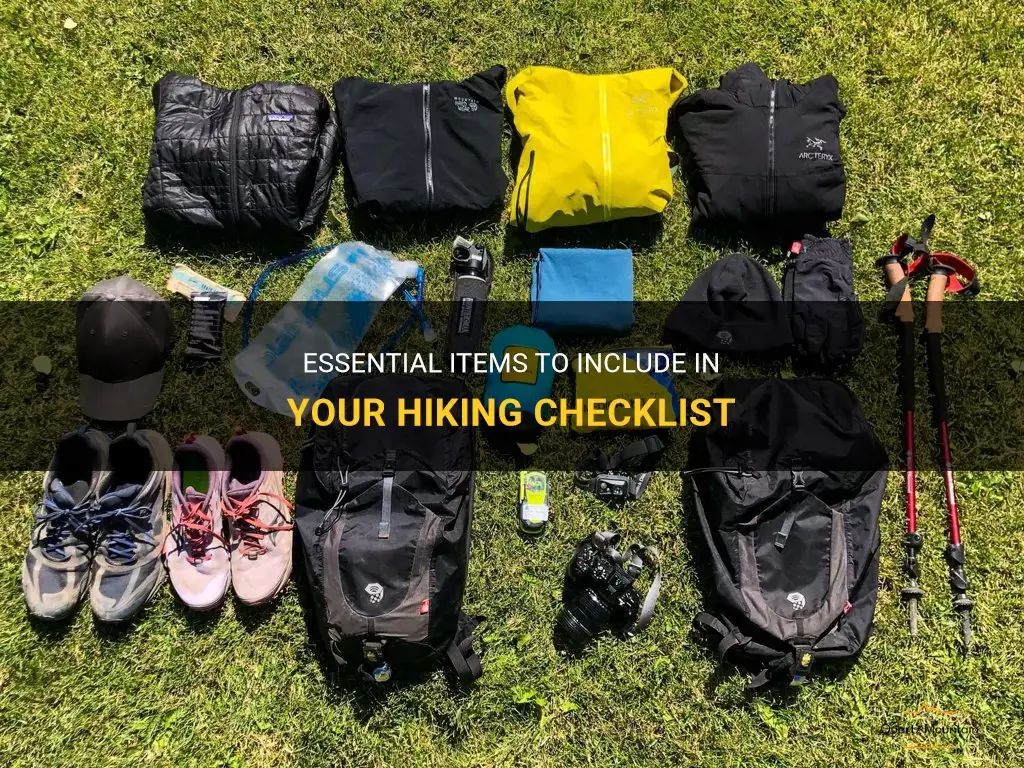
Are you planning a hiking adventure? Before you hit the trails, you need to make sure you have all the essential items in your hiking checklist. Whether you are an experienced hiker or a beginner, having the right gear and supplies can make a world of difference in your outdoor experience. From proper footwear to navigation tools, this article will guide you on the must-have items that should be on your hiking checklist. So let's dive in and get ready for an unforgettable hiking journey!
| Characteristics | Values |
|---|---|
| Clothing | - Hiking boots - Moisture-wicking socks - Long pants - Short-sleeve shirt - Long-sleeve shirt - Fleece or lightweight jacket - Rain jacket - Hat - Gloves - Sunglasses |
| Equipment | - Backpack - Water bottle - Navigation tools (map, compass, GPS) - Headlamp or flashlight - Extra batteries - Whistle - First aid kit - Trekking poles - Multi-tool - Camera or binoculars - Insect repellent |
| Food | - High-energy snacks - Trail mix - Jerky or dried meat - Fresh fruit - Granola bars - Peanut butter or Nutella - Energy bars or gels - Electrolyte drinks |
| Hydration | - Water bottles or hydration bladder - Water filter or purification tablets - Electrolyte packets or tablets |
| Safety | - Personal identification - Emergency contact information - Emergency shelter (tent or bivy sack) - Fire starter or matches - Survival blanket - Sunscreen - Bug spray |
| Miscellaneous | - Extra clothing layers - Extra socks - Rain pants - Bandana or buff - Tissues or toilet paper - Hand sanitizer - Trash bag - Ziplock bags - Cash or credit card - Cell phone - Whistle |
What You'll Learn
- What essential items should be included in a basic hiking gear list?
- Are there any specific clothing items or footwear that should be included in a hiking pack?
- Are there any essential safety items that should always be packed for a hike?
- What types of food and water should be included in a hiking pack?
- Is there any specific gear or equipment that is recommended for different types of hikes or terrains?

What essential items should be included in a basic hiking gear list?
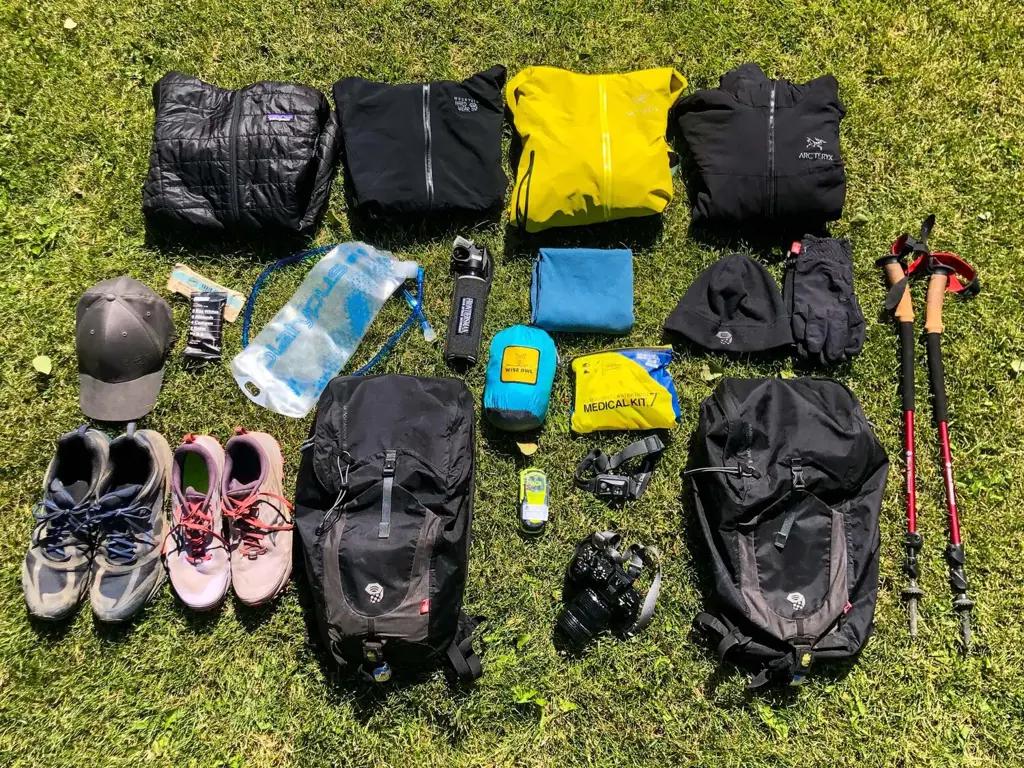
Hiking is a popular outdoor activity that allows individuals to explore and connect with nature. Whether you are a seasoned hiker or a beginner, having a well-equipped gear list is essential to ensure a safe and enjoyable experience. In this article, we will discuss the essential items that should be included in a basic hiking gear list.
- Backpack: A sturdy backpack with a capacity that can hold all your gear is crucial. Look for a backpack with padded shoulder straps and a waist belt for comfortable carrying.
- Map and Compass: It is important to have a detailed map of the hiking trail and a compass to navigate your way. Familiarize yourself with how to read a map and use a compass before heading out.
- Clothing: Dressing in layers is key for hiking, as weather conditions can change quickly. Include moisture-wicking base layers, insulating layers, and a waterproof outer shell to protect against rain and wind. Don't forget to pack extra socks and a hat for added comfort.
- Footwear: Invest in a pair of sturdy hiking boots or shoes that offer good ankle support and traction. Make sure to break them in before the hike to avoid blisters and discomfort.
- Water and Water Filtration: Staying hydrated is crucial while hiking. Carry an adequate amount of water and consider a water filtration system to replenish your supply from natural sources along the way.
- Food and Snacks: Pack enough food to fuel your body during the hike. Consider lightweight, non-perishable options such as energy bars, nuts, and dried fruits.
- First Aid Kit: Accidents can happen while hiking, so it's important to have a basic first aid kit that includes band-aids, gauze, antiseptic ointment, pain relievers, and any necessary medications.
- Sun Protection: Protect yourself from harmful UV rays by wearing sunscreen, sunglasses, and a wide-brimmed hat. You can also consider lightweight, long-sleeved clothing for added sun protection.
- Navigation and Communication Devices: In addition to a map and compass, carrying a GPS device or a smartphone with a hiking app can be useful for tracking your progress and finding your way. Ensure that your phone is fully charged before the hike and consider bringing a portable charger.
- Emergency Shelter: It's always wise to have a lightweight emergency shelter such as a bivvy or a space blanket in case you need to spend the night outdoors unexpectedly.
- Illumination: Carry a headlamp or a flashlight with extra batteries to navigate during low light conditions or in case of emergency situations.
- Multi-tool: A multi-tool with features like a knife, scissors, and screwdrivers can be handy for various tasks on the trail.
- Personal Care Items: Don't forget to pack essential personal care items such as toilet paper, hand sanitizer, insect repellent, and a small trowel for digging catholes.
- Emergency Communication: If you are hiking in remote areas, consider carrying a personal locator beacon (PLB) or a satellite phone for emergency communication.
- Leave No Trace: Finally, ensure that you bring along a trash bag to pack out all your waste and minimize your impact on the environment.
Having these essential items in your hiking gear list will help you prepare for a safe and enjoyable outdoor adventure. Remember to thoroughly plan and research your hiking trail beforehand and always let someone know about your plans and expected return time for added safety. Happy hiking!
Essential Items to Pack for a 5 Day Trip: Your Ultimate Checklist
You may want to see also

Are there any specific clothing items or footwear that should be included in a hiking pack?
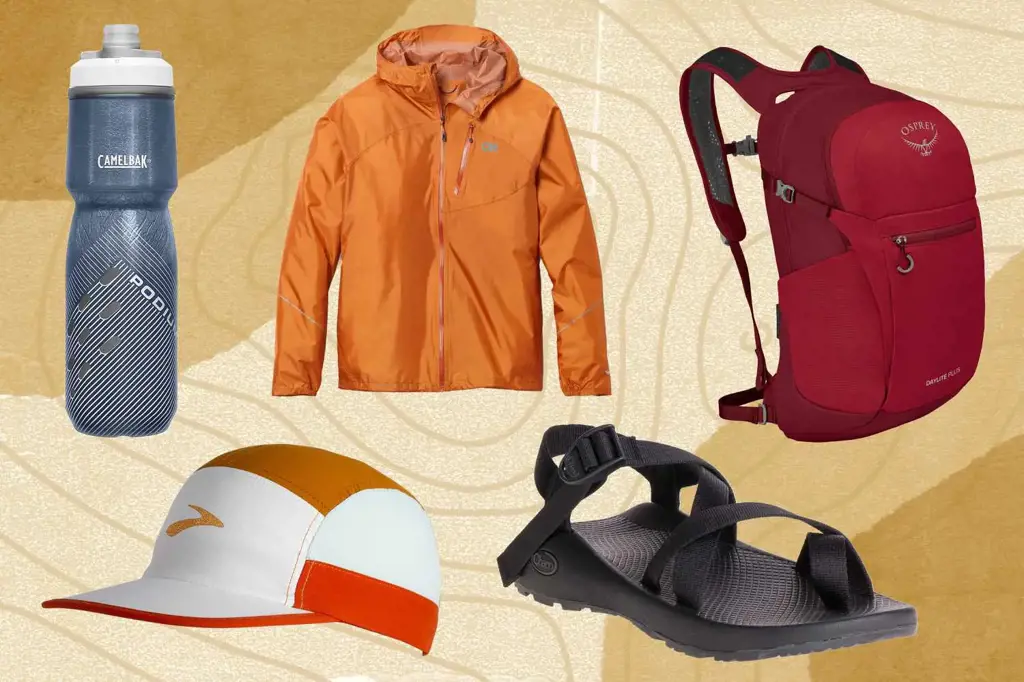
Hiking is a popular outdoor activity that offers numerous physical and mental health benefits. Whether you're exploring a trail in the mountains or trekking through a national park, it's crucial to have the right gear. One essential aspect of your hiking gear is the clothing and footwear you choose to wear. The right clothing and footwear can protect you from the elements and provide comfort throughout your hike. In this article, we will explore the specific clothing items and footwear that should be included in a hiking pack.
Base Layers:
Base layers are the foundation of your hiking outfit. They are designed to manage moisture and provide insulation. When choosing base layers, opt for light and breathable materials such as merino wool or synthetic blends. Merino wool is an excellent choice as it has natural moisture-wicking properties and can keep you warm even when wet.
Moisture-Wicking Shirts:
Moisture-wicking shirts are vital for hiking as they help keep you dry and comfortable by pulling sweat away from your body. Look for shirts made from synthetic materials like polyester or nylon, as they dry quickly and are lightweight.
Hiking Pants/Shorts:
For hiking pants or shorts, choose materials that offer durability and breathability. Nylon or polyester blends are ideal, as they are lightweight, quick-drying, and resistant to abrasions. Pants with zip-off legs can be handy if you anticipate changing weather conditions on your hike.
Insulating Layers:
Depending on the weather, you may need an insulating layer to keep you warm. Fleece jackets or synthetic-fill jackets are excellent options as they provide warmth while also being lightweight and compressible. Layering is key to adjusting your body temperature as you hike, so ensure you have the option to add or remove insulating layers as needed.
Waterproof/Windproof Jackets:
Weather conditions can change quickly when hiking, so it's important to have a waterproof and windproof jacket in your hiking pack. Look for jackets made from breathable materials with sealed seams to keep you dry and protected from the elements.
Hiking Socks:
Investing in high-quality hiking socks is essential to prevent blisters and keep your feet comfortable on long hikes. Look for socks made from materials like merino wool or synthetic blends that offer moisture-wicking properties and cushioning in crucial areas.
Hiking Boots/Shoes:
Choosing the right hiking footwear is crucial for stability, comfort, and safety. Opt for boots or shoes that provide ankle support, cushioning, and good traction. Waterproof or water-resistant footwear is preferable to keep your feet dry during creek crossings or wet trails.
In addition to the clothing items and footwear mentioned above, you should also consider accessories such as hats, gloves, and gaiters to protect you from the sun, cold, and wet terrain. Additionally, remember to pack extra clothing layers in case of unexpected weather changes.
When planning for a hike, it's important to consider the terrain, weather conditions, and the duration of your hike. The clothing and footwear you choose should be appropriate for the specific trail and environment. By investing in high-quality gear and being prepared, you can enjoy your hike comfortably and safely.
A Guide to Packing for Australia Month by Month: Everything You Need to Know
You may want to see also

Are there any essential safety items that should always be packed for a hike?
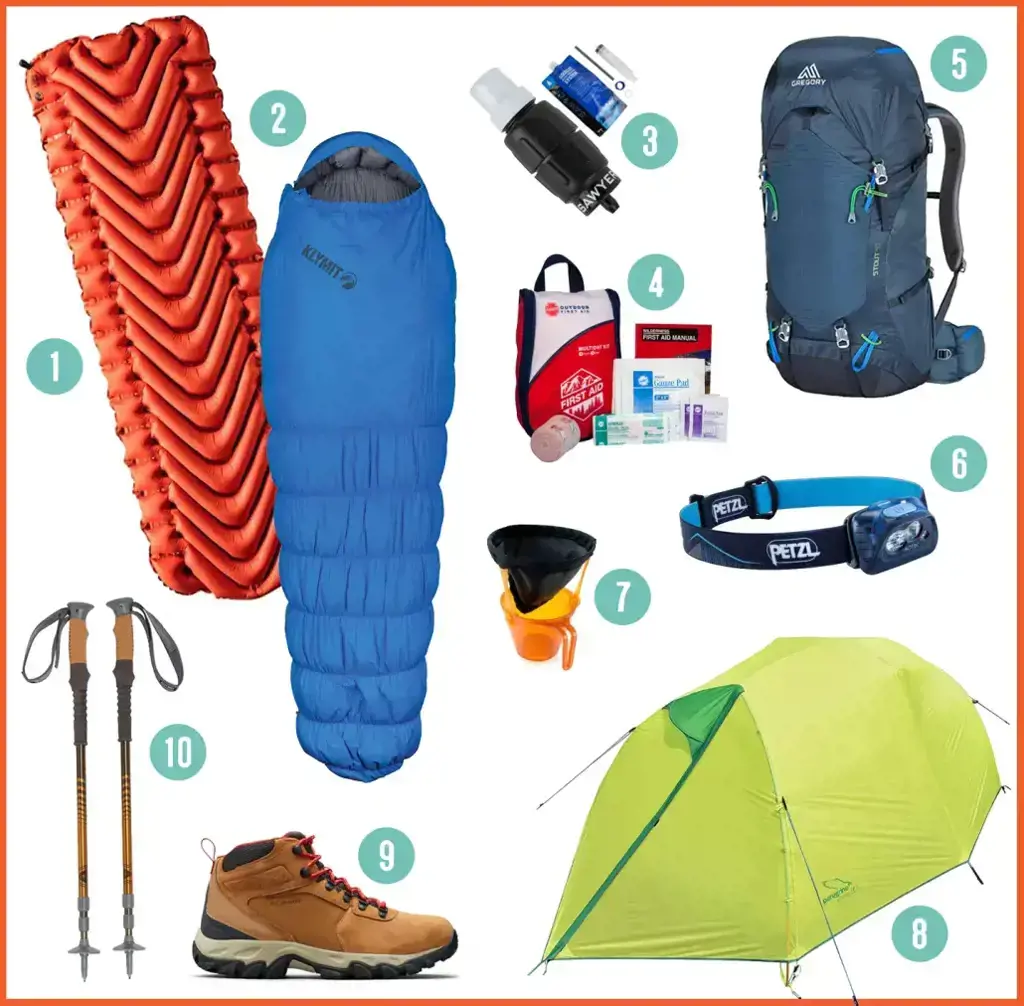
When going on a hike, it is crucial to prioritize safety and be prepared for any unforeseen circumstances. There are several essential safety items that should always be packed to ensure a safe and enjoyable hike. These items can help individuals react effectively to emergencies and overcome challenges that may arise during their outdoor adventure.
One of the most important safety items to pack is a first aid kit. Accidents can happen while hiking, such as cuts, bruises, or sprains. A well-stocked first aid kit should include adhesive bandages, antiseptic wipes, gauze pads, adhesive tape, pain relievers, and tweezers. It is important to ensure that the first aid kit is easily accessible and that hikers know how to use the items inside.
Another essential safety item is a map and compass (or a GPS device). Getting lost is a real possibility while hiking, especially in unfamiliar terrain. Carrying a detailed map and a compass can help hikers find their way back to the trail or civilization. If using a GPS device, it is essential to have extra batteries or a portable charger.
Carrying enough water and food is also crucial for a safe hike. Dehydration can lead to serious health problems, so it is essential to bring an adequate amount of water for the hike's duration. On average, hikers should plan to bring at least two liters of water per person for a full-day hike. Additionally, packing high-energy snacks such as nuts, dried fruits, or energy bars can provide sustenance during the hike.
It is vital to pack appropriate clothing for the hike to ensure comfort and protection from the elements. Layering clothing is a good strategy as it allows hikers to adjust their attire based on temperature changes. Wearing a moisture-wicking base layer, insulating mid-layer, and waterproof outer layer can protect against various weather conditions. Additionally, packing extra socks and a hat can help prevent blisters and heat loss.
Hiking in the wilderness means being exposed to various insects, so it is essential to bring insect repellent. Mosquitoes, ticks, and other insects can carry diseases, so using an effective repellent can prevent potentially serious health issues. It is important to read and follow the instructions on the insect repellent's label for proper application.
Other safety items that should be packed include a whistle, a headlamp or flashlight, and a multi-tool. A whistle can be used to signal for help in case of an emergency. A headlamp or flashlight is crucial in case darkness falls and hikers need to find their way or set up camp. A multi-tool can come in handy for various tasks, such as repairing gear or cutting through obstacles.
In conclusion, there are several essential safety items that should always be packed for a hike. These items include a first aid kit, a map and compass or GPS device, enough water and food, appropriate clothing, insect repellent, a whistle, a headlamp or flashlight, and a multi-tool. Being prepared with these safety items can help hikers tackle any challenges or emergencies they may encounter during their outdoor adventure. Remember to always check the condition and expiry dates of these items before heading out to ensure their effectiveness during the hike.
What to pack for a 10-week backpacking trip in Latin America
You may want to see also

What types of food and water should be included in a hiking pack?
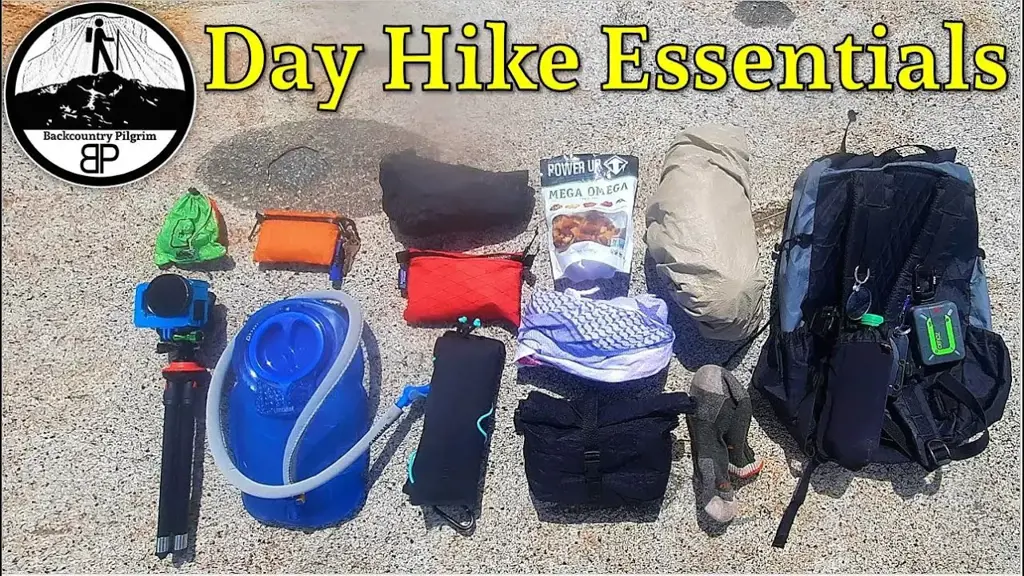
When preparing for a hike, it is crucial to pack the right types of food and water to ensure that you stay properly fueled and hydrated throughout your adventure. Whether you are embarking on a short day hike or a multi-day trek, it is essential to consider the nutritional content, weight, and portability of the food and water you bring along.
When it comes to water, experts recommend carrying at least two liters per person for a full day of hiking. However, depending on the length and intensity of your hike, you may need to adjust this amount accordingly. It is also advisable to bring a water filtration system or purification tablets, especially if you are hiking in remote areas where clean water sources might be limited. This will allow you to replenish your water supply from natural sources such as rivers and streams.
In terms of food, it is important to choose lightweight, non-perishable options that provide a good balance of carbohydrates, proteins, and fats. Here are some examples:
- Trail mix: A mix of nuts, dried fruits, and seeds is an excellent snack option for hiking. It is lightweight, provides essential nutrients, and offers a good amount of energy.
- Energy bars: There are numerous energy bars available on the market, offering various flavors and nutritional profiles. Look for bars that are high in calories, protein, and fiber to keep you energized and satisfied during your hike.
- Jerky: Beef or turkey jerky is a great source of protein and can be easily packed. It is a savory option that can help keep hunger at bay without taking up much space in your backpack.
- Nut butter packets: Single-serving packets of peanut butter or almond butter are convenient and provide a good source of healthy fats. They can be paired with crackers or used as a spread on tortillas for a quick and easy snack.
- Dehydrated meals: For multi-day hikes or backpacking trips, dehydrated meals can be a lifesaver. These meals are lightweight, easy to prepare, and come in a variety of flavors and options. Just add boiling water, let it sit for a few minutes, and you have a hot meal ready to eat.
- Fresh fruits and vegetables: While fresh produce may not last as long as other options, they can be a refreshing and nutritious addition to your hiking pack. Apples, oranges, carrots, and cherry tomatoes are all durable options that can withstand the journey.
It is important to note that your nutritional needs may vary depending on factors such as activity level, climate, and personal preferences. It is always a good idea to consult with a nutritionist or healthcare professional to determine the best food choices for your specific needs.
In conclusion, when packing food and water for a hike, it is essential to consider factors such as nutritional content, weight, and portability. Bringing lightweight, non-perishable options that provide a good balance of carbohydrates, proteins, and fats, along with an adequate supply of water, can help ensure that you stay energized and hydrated during your hiking adventure.
What to Pack for a Trip to NYC: Essential Items to Bring for an Unforgettable Experience
You may want to see also

Is there any specific gear or equipment that is recommended for different types of hikes or terrains?
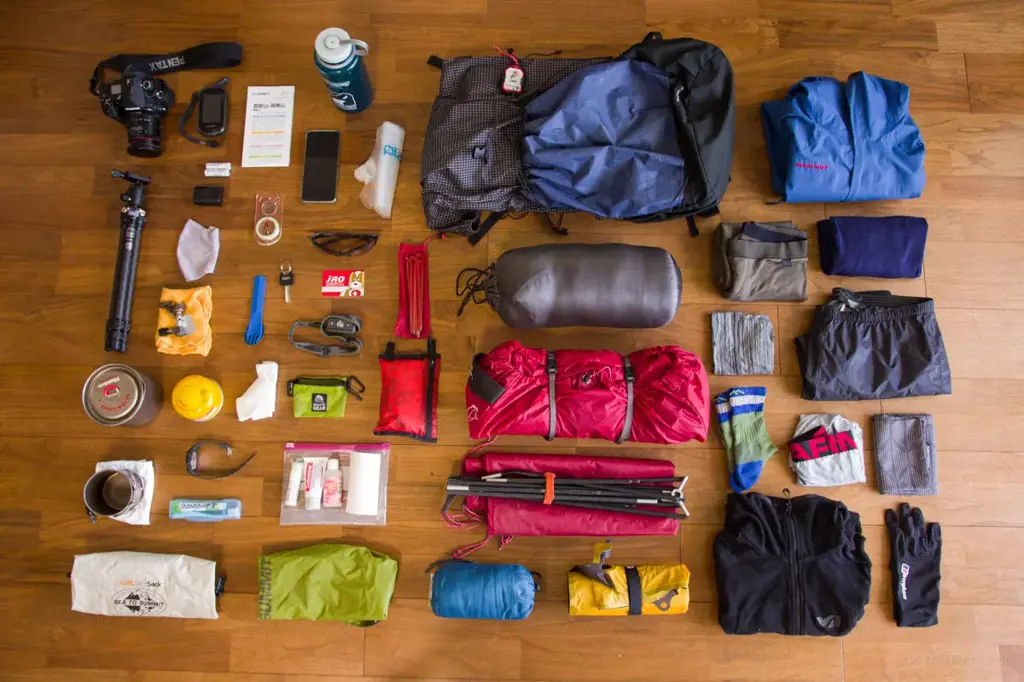
When it comes to hiking, having the right gear and equipment is crucial for a successful and enjoyable experience. The specific gear and equipment needed can vary depending on the type of hike or terrain you will be tackling. In this article, we will explore some of the recommended gear for different types of hikes and terrains.
Day hikes:
For day hikes on easy to moderate terrains, the following gear is generally recommended:
- Hiking boots or shoes: Choose footwear that provide good ankle support and have a sturdy sole for traction.
- Backpack: A small to medium-sized backpack is necessary to carry essentials such as water, snacks, a map, and extra layers of clothing.
- Water bottle or hydration system: Staying hydrated is important, so having a reliable water source is essential.
- Navigation tools: Carry a map, compass, or GPS device to help you stay on the right track.
- Sun protection: Don't forget to pack sunscreen, a hat, and sunglasses to protect yourself from the sun's harmful rays.
- First aid kit: Accidents can happen, so having a basic first aid kit on hand is advisable.
Multi-day hikes:
For longer hikes that span multiple days and involve camping along the way, you will need additional gear and equipment. In addition to the essentials mentioned above, consider packing the following items:
- Tent: A lightweight and compact tent will provide shelter during overnight stays.
- Sleeping bag and sleeping pad: Ensure you have a warm and comfortable sleeping bag and a sleeping pad for insulation from the ground.
- Cooking equipment: A stove, fuel, and cookware are necessary for preparing meals on the trail.
- Water filtration system: Depending on the availability of clean water sources, you may need a water filtration system to ensure safe drinking water.
- Extra clothing: Pack extra layers of clothing, including warm jackets, hats, and gloves, to prepare for changing weather conditions.
- Toiletries and personal hygiene items: Don't forget essentials such as toilet paper, hand sanitizer, and toothbrushes.
Challenging terrains:
If you are planning to tackle more challenging terrains like mountains, glaciers, or deserts, specialized gear and equipment may be necessary. These may include:
- Mountaineering boots: These boots have rigid soles and crampon-compatible designs for better traction on icy or rocky terrains.
- Ice axe and crampons: Necessary for traversing glaciers or icy slopes.
- Climbing harness and ropes: These are important for glacier crossings and technical climbing.
- Gaiters: These protect your legs and boots from snow, mud, or debris.
- High-altitude gear: If you will be hiking at high altitudes, additional gear such as oxygen systems or altitude sickness medication might be required.
It's important to note that the specific gear and equipment needed can vary depending on factors such as the season, weather conditions, and personal preferences. Before embarking on any hike, research the terrain, consult experienced hikers or guides, and ensure you have the appropriate gear for your specific adventure.
In conclusion, having the right gear and equipment is essential for a safe and enjoyable hiking experience. Different types of hikes and terrains require different gear, so tailor your equipment to the specific challenges you will face. Whether you're going on a day hike or tackling challenging mountainous terrains, proper preparation and gear selection will greatly enhance your experience while keeping you safe.
The Essential Packing Checklist for a Summer Holiday
You may want to see also
Frequently asked questions
When preparing for a hike, it is important to pack several essential items. These include a map and compass for navigation, a headlamp or flashlight for visibility in low-light conditions, extra layers of clothing for changing weather, a first aid kit for emergencies, water and snacks for hydration and fuel, and a multi-purpose tool or knife. Additionally, make sure to have a fully charged cellphone and a portable charger for communication and emergencies.
For a day hike, you may not need as much gear as you would for an overnight trip, but there are still some essential items to pack. Apart from the basics like water, food, and a map, some additional items include sunscreen and bug repellent, a hat and sunglasses for sun protection, a lightweight rain jacket or poncho in case of unexpected rain, and hiking poles for added stability and support. It's also a good idea to pack a small emergency shelter, such as a lightweight tarp, in case you get stranded or need to take shelter from the elements.
When planning for an overnight hike, it's important to consider the duration of your trip and the terrain you'll be encountering. In addition to the items mentioned earlier, you will need to pack camping gear such as a tent, sleeping bag, sleeping pad, and cooking supplies if you plan on preparing meals. You may also want to bring extra clothing, including warm layers and a change of clothes, as well as toiletries, a lightweight stove, and food for the duration of your trip. It is also crucial to check the regulations of the area you'll be hiking in and ensure you have the necessary permits and bear canisters if required.







